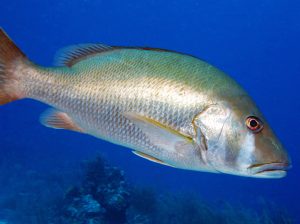
Dog Snapper
The Dog Snapper (Lutjanus jocu) is a species of snapper found in the Western Atlantic Ocean, particularly in the Caribbean Sea and the Gulf of Mexico. Here are some interesting facts about the Dog Snapper:
Appearance: Dog Snappers have a robust and elongated body with a slightly sloping forehead. They can grow quite large, with adults reaching lengths of up to 3 feet (1 meter) and weighing over 30 pounds (14 kilograms). They have a distinctive coloration, usually ranging from reddish-brown to grayish-blue on their upper body, fading to a lighter shade on their lower body. Younger individuals often have a pattern of dark, vertical bars on their sides, which tend to fade as they mature.
Distribution: Dog Snappers are primarily found in the Western Atlantic Ocean, specifically in the Caribbean Sea and the Gulf of Mexico. They are a tropical species and are commonly encountered in the warm waters of the region.
Habitat: These snappers inhabit a variety of habitats, including coral reefs, rocky outcrops, seagrass beds, and mangrove areas. They are known to have a preference for deeper waters, typically found at depths ranging from 30 to 200 feet (9 to 60 meters). Juveniles are often found in shallower areas and estuaries.
Feeding Behavior: Dog Snappers are opportunistic predators that feed on a wide range of prey. Their diet includes fish, crustaceans, mollusks, and other small marine organisms. They are skilled ambush predators, using their sharp teeth and strong jaws to capture their prey.
Behavior: Dog Snappers are generally solitary fish but may be found in small groups during certain periods, such as spawning. They are primarily nocturnal, becoming more active and feeding at night. During the day, they often take shelter in crevices or caves within their preferred habitats.
Reproduction: Dog Snappers are known to gather in large aggregations for spawning, usually during the summer months. They are protogynous hermaphrodites, which means they start their lives as females and can later transition to males as they grow larger and older. Spawning occurs offshore, where the females release their eggs into the water column, and the fertilization takes place externally.
Conservation Status: The Dog Snapper is not currently assessed as a separate species by the International Union for Conservation of Nature (IUCN). However, as a member of the snapper family, it faces similar threats, such as overfishing and habitat degradation. Proper fisheries management and habitat protection are essential to ensure the sustainability of Dog Snapper populations.